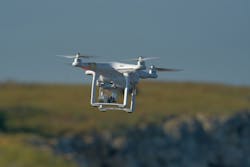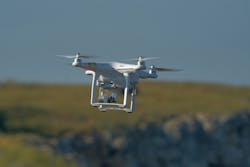Ever since aerial drones started becoming a popular thing for hobbyists to own and fly at their leisure, I’ve wanted one. I kept putting it off because I wanted a good one, but didn’t want to pay top dollar for it. Thankfully, I have an uncle-in-law who had good one who was looking to sell it and upgrade to an even better one. I acquired it from him over Christmas and he gave me a nice family discount.
Besides being fun to fly for consumers, commercial use of aerial drones has enabled numerous industries to add productive activities that either weren’t possible before, or too dangerous, time-consuming, or expensive for a human to do. These drones are everywhere in the air today, and their applications are seemingly endless. They are now widely used in agriculture, security, construction, photography, search & rescue, maintenance, and filmmaking, to name a few. We can also soon expect drones to be used for parcel delivery. News pops up of a new Amazon drone delivery patent seemingly every month, which we covered extensively at my previous publication, Industrial Distribution.
The U.S. began developing flying drone—or unmanned aerial vehicle (UAV—technology as early as during WWI, but it’s grand potential is in the commercial sector. A February 2018 report from research firm Global Market Insights forecasts the global commercial drone market value to exceed $17 billion by 2024.
The Bad
Sadly, the powerful potential of UAVs is often soured by news of accidents caused by them. In February of this year, a helicopter crash-landed in South Carolina, and its student pilot and instructor both told investigators that a small drone appeared right in front of them, causing the instructor to swerve, which led to the helicopter tail hitting a tree or bush that led to the crash. The investigation is reportedly still ongoing, but if it turns out that the drone indeed caused the crash, it would be the first such case in the U.S. Similarly, in September 2017, an amateur pilot flew his Phantom 4 drone into a Black Hawk Army helicopter in Staten Island, NY. The helicopter landed safely, but its main rotor blade, window frame and transmission deck were damaged. There are numerous other examples of accidents, or near-misses that could have been fatal. Thankfully, I’ve yet to see news of a residential or commercial UAV causing a fatality, which is surprising.
On Dec. 20, tens of thousands of passengers at Britain’s Gatwick Airport were delayed, diverted or stuck on planes Thursday as the only runway there remained closed for a second-straight day after two drones were spotted over the airfield.
Earlier this year, the University of Dayton Research Institute’s impact physics lab simulated what would happen if a UAV collided with a manned aircraft. They launched a small quadcopter drone out of a cannon at 238 mph (383 km/h) directly into a small airplane’s wing. Check out the lab’s video below, in which the results speak for themselves:
The Good
On the flip side, drones are also doing an immense amount of good. In the aftermath of November’s three-week-long Camp Fire in Northern California—the most devastating wildfire in state history—16 emergency responder agencies conducted 518 UAV flights to map the entire 17,000+ acre fire zone, collecting 70,000 images and 1.4 trillion pixels of data. It is said to be the largest drone response to a disaster scene in U.S. history.
In the aftermath of Hurricane Maria, which resulted in nearly 3,000 deaths in Puerto Rico, UAVs were used as flying cell towers to restore cellular service on the island. Much of Puerto Rico’s power grid was decimated by Maria, and the use of Flying COWS (Cell on Wings) were created by AT&T to act like a flying cell tower.
There’s plenty of other great news about drones playing a hugely valuable role in disaster recovery.
In February of 2017, a UAV was credited with helping find five missing snowboarders and skiers in British Columbia, Canada who were missing for several days and in danger of being trapped in a gully. A volunteer rescue team deployed drones with infrared cameras to track down the group, and the rescue team says it was the first documented missing person located by a search-and-rescue team using infrared cameras in British Columbia.
Again, you can find numerous other examples of aerial drones doing great things, as well as drones behaving badly. And it seems that as UAV technology advances, the potential for it doing good is matched by fears of drones being used for things like terrorism. As long as there are drones, it will probably always be that way. The nature with any technology is that we have to take the good with the bad.
Meanwhile, I’ll try to not end up on the “bad” news while flying my newly-acquired drone.
About the Author


